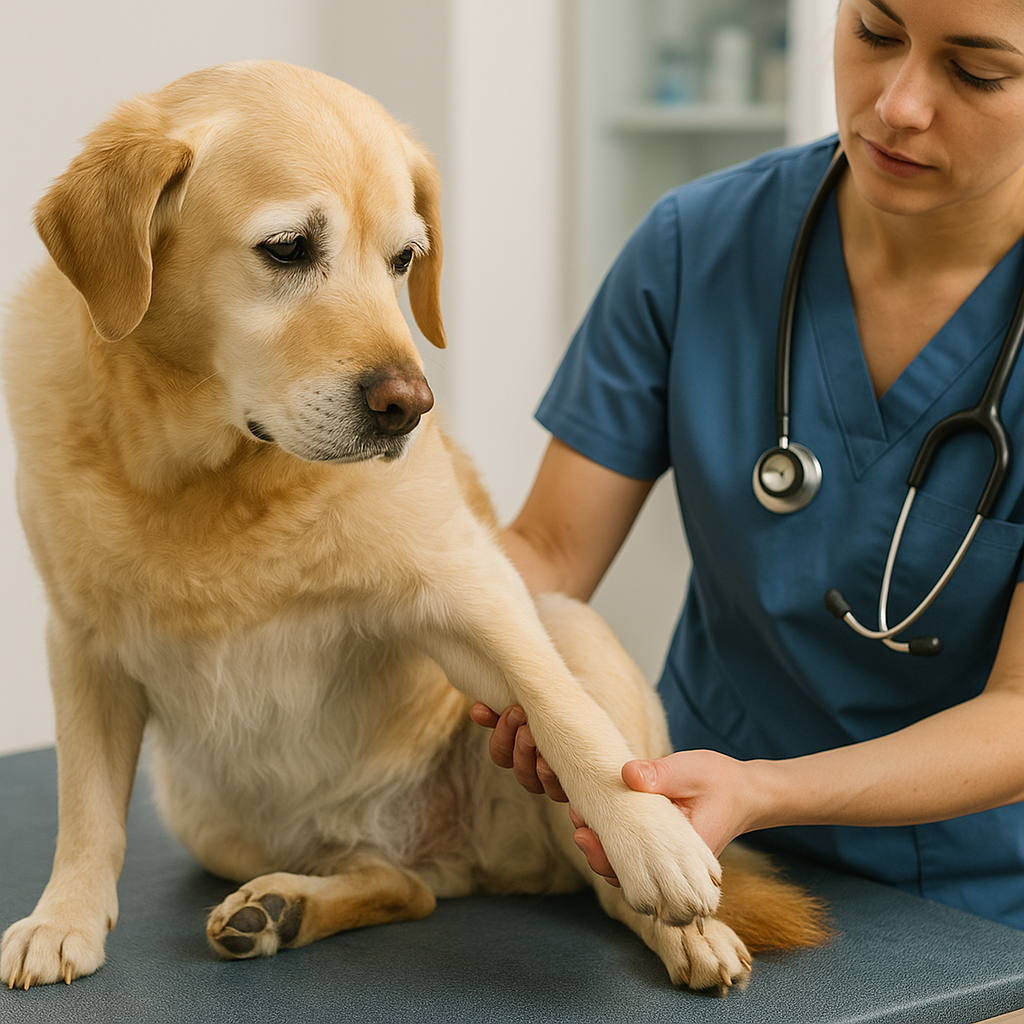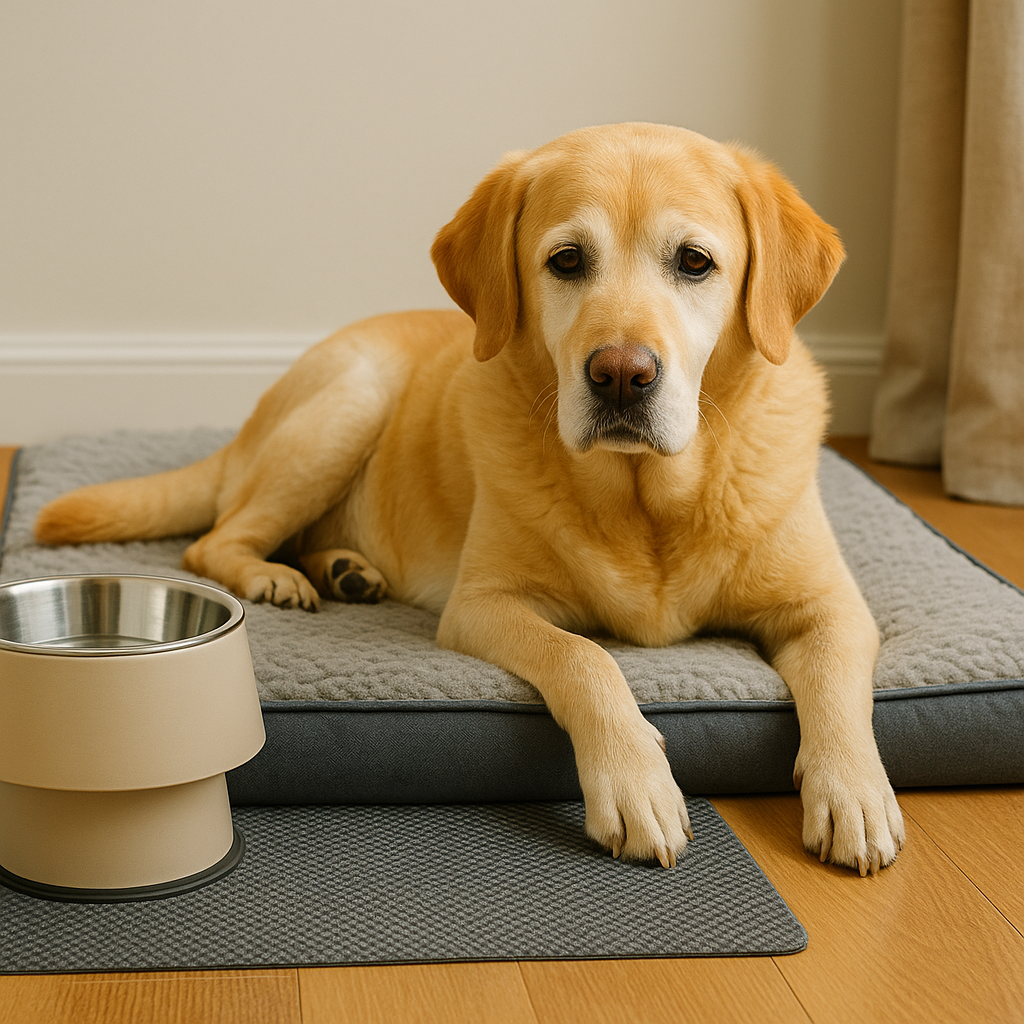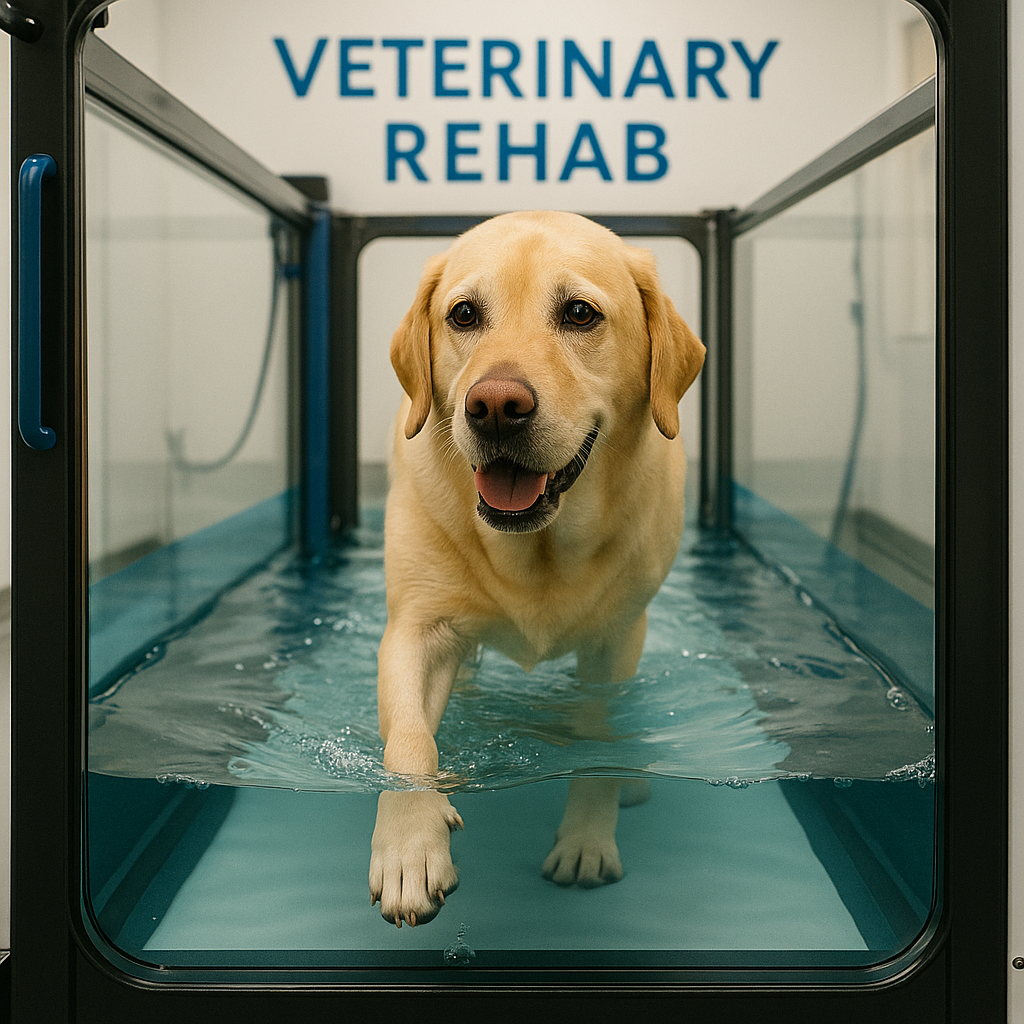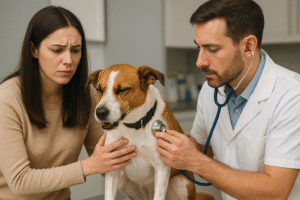Watching your dog slow down or struggle with movement can be heartbreaking. As a veterinarian in Ottawa, I’ve seen countless pet parents come in worried that their once-bouncy pup now hesitates at the stairs or limps after a nap. The good news? Catching arthritis early gives you the best shot at keeping your dog active and comfortable for years to come.
Key Takeaways
(Your quick-start guide to understanding and managing arthritis in dogs)
- Arthritis is common in aging dogs but can start early, especially in large or overweight breeds.
- Early signs include stiffness, limping, reluctance to move, and mood changes.
- Prompt diagnosis by a vet is crucial X-rays and exams confirm arthritis and rule out other issues.
- Managing your dog’s weight, adding joint supplements, and adjusting exercise can greatly ease discomfort.
- Vet prescribed medications and supportive therapies like physiotherapy or acupuncture can improve quality of life.
- Small home changes like ramps or non-slip mats can prevent slips and help arthritic dogs stay independent.
Table of Contents
What Is Canine Arthritis?
Canine arthritis, also known as osteoarthritis or degenerative joint disease (DJD), is a progressive condition where the protective cartilage in a dog’s joints wears down over time. This loss of cartilage causes the bones to rub against each other, leading to pain, inflammation, and reduced mobility.
In my clinic, I often explain to pet owners that arthritis isn’t just “getting old” it’s a medical condition we can manage. Just like in humans, arthritis in dogs ranges in severity and can affect different joints. The hips, knees, elbows, and spine are the most commonly affected areas.
Causes of Arthritis in Dogs
Arthritis doesn’t appear out of nowhere. It often results from one or more underlying issues:
- Age-related wear and tear
- Genetic joint issues, like hip or elbow dysplasia
- Past injuries (e.g., ligament tears or fractures)
- Joint infections or inflammation
- Poor joint alignment from a young age
- Excess weight, which puts more stress on joints
At-Risk Breeds and Factors
Some breeds are more prone due to their size or genetic predisposition:
- Labrador Retrievers
- German Shepherds
- Golden Retrievers
- Rottweilers
- Newfoundlands
Other risk factors include:
- Obesity
- Lack of regular exercise
- Poor nutrition during puppyhood
- High-impact activities (e.g., excessive jumping)
Next up, we’ll go over the early signs to help you spot arthritis before it worsens. Early signs of arthritis in dogs
Early Signs of Arthritis in Dogs
Arthritis can sneak up quietly. Most pet parents don’t notice an obvious limp right away instead, they see small changes in behavior or movement. Spotting these early signs can make a big difference in slowing the disease.
Subtle Symptoms to Watch
- Stiffness after rest: Your dog may struggle to stand after lying down, especially in the morning.
- Limping or favoring a limb: This might fade as they warm up, but it often returns after activity.
- Reluctance to jump or climb: Hesitating to go upstairs, hop in the car, or onto furniture.
- Reduced activity: Shorter walks, avoiding play, or needing more naps.
- Changes in mood: Dogs in pain may seem withdrawn, grumpy, or less tolerant of touch.
- Muscle loss: Over time, a dog may lose muscle around affected joints.
- Joint swelling or heat: Sometimes the area feels warm or puffy.
In my experience, dogs with arthritis often “slow down” before showing a clear limp many owners chalk it up to aging. But these subtle clues are worth mentioning to your vet early.
How Arthritis Progresses Over Time
Without treatment, arthritis typically worsens:
- Mild discomfort becomes chronic pain
- Joints stiffen, mobility declines
- Muscle wasting increases
- Dogs may struggle with basic tasks like standing, walking, or toileting
Catching it early allows for interventions that reduce suffering and prolong your dog’s mobility.
How Veterinarians Diagnose Arthritis

If you suspect your dog has arthritis, don’t wait to “see how it goes.” A proper veterinary diagnosis helps rule out other conditions like ligament tears, infections, or neurological issues and ensures the right treatment plan.
Physical Exam
Your vet will start by watching your dog walk, sit, and lie down. They’ll check:
- Range of motion in affected joints
- Pain response when the joints are gently manipulated
- Muscle tone and symmetry
- Signs of joint swelling or crepitus (a crackling sound from joint friction)
A hands-on exam often gives immediate clues but more information is usually needed to confirm the diagnosis.
Imaging and Lab Work
- X-rays (radiographs): The gold standard to visualize bone changes, joint narrowing, or new bone growth (osteophytes)
- CT or MRI scans: Occasionally used in complex or surgical cases
- Blood tests: Help rule out infection or autoimmune causes of joint pain
Diagnosing arthritis early allows for proactive care I’ve seen dogs stay mobile for years with the right plan.
Next, let’s look at what you can do at home to make life easier for your dog.
How to Help a Dog with Arthritis at Home

Managing arthritis at home doesn’t have to be complicated. With a few adjustments and consistent care, you can dramatically improve your dog’s comfort and mobility. Here’s how I guide my clients through arthritis support, step-by-step.
5-Minute Home Comfort Checklist
Quick ways to make your dog’s day easier:
- ✅ Soft orthopedic bed in a warm, draft-free spot
- ✅ Non-slip rugs or yoga mats on slippery floors
- ✅ Pet stairs or ramps to furniture or car
- ✅ Raised food and water bowls
- ✅ Daily gentle brushing to check for muscle loss or swelling
Weight Management & Nutrition
Extra pounds worsen joint strain. Ask your vet if your dog’s weight is ideal. Key tips:
- Switch to a vet-approved weight-control diet
- Measure portions and avoid free feeding
- Offer low-cal treats like green beans or carrots
- Schedule monthly weight checks
According to the CVMA, just a 10% weight loss can significantly reduce arthritis symptoms.
Gentle Exercise Tips
Movement helps maintain joint flexibility and muscle tone. Avoid high-impact activity.
Do:
- Leashed walks on soft ground
- Short, frequent walks instead of one long one
- Swimming or underwater treadmill (if available)
Avoid:
- Jumping for balls
- Running on hard surfaces
- Slippery floors
Watch for signs of fatigue or soreness after activity.
Effective Joint Supplements

Supplements don’t cure arthritis, but many help slow cartilage breakdown and reduce inflammation. Always ask your vet first. Commonly used products:
| Supplement | Benefits | Example Product |
|---|---|---|
| Glucosamine & Chondroitin | Supports cartilage repair | Dasuquin |
| Omega-3 (Fish Oil) | Reduces inflammation | Grizzly Salmon Oil |
| Green-Lipped Mussel | Anti-inflammatory properties | Antinol Rapid |
| MSM (Methylsulfonylmethane) | Joint comfort | Found in many combo formulas |
Vet-Prescribed Pain Relief
For moderate to severe arthritis, medication is often needed:
- NSAIDs (e.g., meloxicam, carprofen): Reduce inflammation and pain
- Gabapentin: Good for chronic or nerve-based pain
- Amantadine or Tramadol: Sometimes used in combination
Never give over-the-counter human meds (like Advil or Tylenol)—these can be toxic to dogs.
Adapting Your Home
Simple changes can reduce pain flare-ups and prevent injury:
- Add ramps or steps for furniture access
- Use carpet runners on stairs
- Keep nails trimmed to prevent slipping
- Warm compresses before bed can help soothe stiffness
Next, we’ll explore additional therapies beyond the basics.
Additional Therapies That Can Help
Beyond supplements and daily care, many dogs benefit from professional therapies especially those with moderate to advanced arthritis. These approaches can ease pain, improve strength, and slow joint degeneration.
Canine Physiotherapy

Just like in people, physical rehab for dogs boosts strength, mobility, and comfort. It’s become a cornerstone of arthritis care in my clinic.
Common techniques include:
- Underwater treadmill: Reduces joint impact while building muscle
- Therapeutic exercises: Balance boards, weight shifting, stretching
- Massage therapy: Relieves tight muscles and boosts circulation
Certified canine rehab practitioners (like CCRPs or CCRTs) can design custom programs.
Acupuncture & Laser Therapy
Both are non-invasive, low-risk options I’ve used successfully in many arthritic dogs:
- Acupuncture: Uses fine needles to stimulate nerves and release endorphins
- Class IV laser therapy: Delivers infrared light to reduce inflammation and pain
Some dogs relax so much during sessions that they fall asleep!
Heat and Cold Packs
Used at home with guidance:
- Cold therapy: Best during flare-ups or after activity to reduce swelling
- Heat therapy: Helps loosen stiff joints in the morning or before walks
Caution: Always use a cloth barrier and limit sessions to 10–15 minutes. Never apply heat to a swollen or warm joint.
Next, we’ll look at when to call the vet and what changes might signal worsening arthritis.
When to Call the Vet
Even with a solid home care routine, there are times when professional help is needed. Arthritis in dogs is a progressive disease, so regular check-ins help catch flare-ups or complications early.
Warning Signs That Need Attention
Call your veterinarian if you notice:
- Increased limping or stiffness, especially if sudden
- Joint swelling or warmth that wasn’t there before
- Behavior changes, like snapping, hiding, or whining
- Loss of appetite or weight loss
- Medication or supplements seem less effective
In my practice, I often adjust treatment every 6–12 months as a dog’s arthritis changes. Sometimes that means a new medication, adding therapy, or tweaking exercise routines.
Don’t wait until your dog is struggling early intervention leads to better long-term comfort.
Next, I’ll share a typical cost breakdown for managing arthritis in dogs across Canada.
Typical Cost of Arthritis Care in Canada
Arthritis care can vary depending on severity, treatment choices, and where you live. Here’s a general breakdown based on average Canadian veterinary pricing as of 2025:
| Item | Estimated Monthly Cost (CAD) | Notes |
|---|---|---|
| Veterinary NSAIDs | $60–$120 | Long-term use, includes rechecks/labs |
| Joint Supplements | $30–$80 | Varies by brand and size of dog |
| Fish Oil or Omega-3 | $20–$40 | Choose veterinary-grade for quality |
| Canine Physiotherapy | $60–$150 per session | Often weekly at first, then monthly |
| Acupuncture or Laser Therapy | $50–$100 per session | May be combined in clinics |
| Orthopedic Dog Bed | $100–$250 (one-time) | Consider memory foam support |
| Ramps or Pet Stairs | $50–$200 (one-time) | Prices vary by size and material |
Pro Tip: Some pet insurance policies cover arthritis treatment, especially if diagnosed after enrollment. Ask your provider about chronic care coverage.
Next, we’ll look at how you can help prevent arthritis or delay its onset in younger dogs.
Arthritis Prevention Tips
While you can’t always prevent arthritis especially if your dog is genetically predisposed you can take steps to delay its onset or reduce its severity. I often talk to puppy and young dog owners about this early on.
How to Reduce Risk in Young Dogs
- Maintain a healthy weight: Start young. Overweight puppies are at greater risk for joint damage.
- Feed large-breed puppies properly: Use veterinary-recommended large-breed puppy formulas to support steady growth and avoid bone stress.
- Avoid high-impact activities: No excessive jumping or intense fetch, especially before 12–18 months in large breeds.
- Encourage safe play: Controlled, soft-surface exercise is great. Rough play on hard ground can cause joint trauma.
- Use supplements preventively (if advised): Some vets recommend starting omega-3s or green-lipped mussel early in high-risk breeds.
- Regular vet checks: Catch early joint issues (like hip dysplasia) before they worsen.
By investing in joint health early, you may buy your dog many more years of easy movement.
Next, we’ll cover common questions pet parents ask about arthritis in dogs.
Frequently Asked Questions About Dog Arthritis
Here are answers to the most common questions I get from concerned dog owners in clinic:
What’s the best supplement for dog arthritis?
There’s no one-size-fits-all answer. Many dogs benefit from a combination of glucosamine, chondroitin, omega-3s, and green-lipped mussel. I often recommend Dasuquin or Antinol Rapid, but always check with your vet before starting.
How long can a dog live with arthritis?
With good management, dogs can live comfortably for years. Arthritis is chronic, but not immediately life-limiting. The key is adapting their care as the disease progresses.
Is arthritis in dogs painful all the time?
Not necessarily. Pain levels can fluctuate, especially with weather or overexertion. Some dogs feel fine most days but have occasional flare-ups. That’s why consistent care is crucial.
Can young dogs get arthritis?
Yes—especially if they’ve had joint injuries, developmental issues like hip dysplasia, or are genetically predisposed. I’ve diagnosed arthritis in dogs as young as two years old.
What’s the safest pain relief for dogs with arthritis?
Veterinary NSAIDs are the most commonly prescribed and well-researched options. They’re safe long-term when used with bloodwork monitoring. Never use human pain meds unless prescribed by a vet.
Next, we’ll wrap up with a final word of encouragement.
Final Thoughts: Helping Your Dog Live Well with Arthritis
Arthritis in dogs isn’t the end of tail wags, playtime, or peaceful walks—it’s just the beginning of a new chapter in how you care for your companion. With a mix of veterinary guidance, home modifications, joint support, and your attention, many dogs live long, happy lives despite their diagnosis.
As a vet, I’ve seen arthritic dogs regain their zest for life with just a few small changes. Whether it’s a new supplement, a warm bed, or shorter, more mindful walks, what you do truly matters. Your dog may not be able to say thank you, but their comfort, mobility, and wagging tail will show it.
And remember: you’re not alone. Don’t hesitate to ask your vet for help—that’s what we’re here for.




